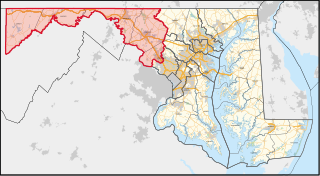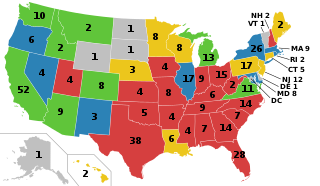
In United States constitutional law, the political question doctrine holds that a constitutional dispute that requires knowledge of a non-legal character or the use of techniques not suitable for a court or explicitly assigned by the Constitution to the U.S. Congress, or the President of the United States, lies within the political, rather than the legal, realm to solve, and judges customarily refuse to address such matters. The idea of a political question is closely linked to the concept of justiciability, as it comes down to a question of whether or not the court system is an appropriate forum in which to hear the case. This is because the court system only has the authority to hear and decide a legal question, not a political one. Legal questions are deemed to be justiciable, while political questions are nonjusticiable. One scholar explained:
The political question doctrine holds that some questions, in their nature, are fundamentally political, and not legal, and if a question is fundamentally political ... then the court will refuse to hear that case. It will claim that it doesn't have jurisdiction. And it will leave that question to some other aspect of the political process to settle out.

The Wisconsin State Assembly is the lower house of the Wisconsin Legislature. Together with the smaller Wisconsin Senate, the two constitute the legislative branch of the U.S. state of Wisconsin.

North Carolina is currently divided into 14 congressional districts, each represented by a member of the United States House of Representatives. After the 2000 census, the number of North Carolina's seats was increased from 12 to 13 due to the state's increase in population. In the 2022 elections, per the 2020 United States census, North Carolina gained one new congressional seat for a total of 14.

Maryland's 6th congressional district elects a representative to the United States House of Representatives from the northwest part of the state. The district comprises all of Garrett, Allegany, Frederick, and Washington counties as well as a portion of Montgomery County. David Trone (D) is its current representative.
League of United Latin American Citizens v. Perry, 548 U.S. 399 (2006), is a Supreme Court of the United States case in which the Court ruled that only District 23 of the 2003 Texas redistricting violated the Voting Rights Act. The Court refused to throw out the entire plan, ruling that the plaintiffs failed to state a sufficient claim of partisan gerrymandering.
Vieth v. Jubelirer, 541 U.S. 267 (2004), was a United States Supreme Court ruling that was significant in the area of partisan redistricting and political gerrymandering. The court, in a plurality opinion by Justice Antonin Scalia and joined by Chief Justice William Rehnquist and Justices Sandra Day O'Connor and Clarence Thomas, with Justice Anthony Kennedy concurring in the judgment, upheld the ruling of the District Court in favor of the appellees that the alleged political gerrymandering was not unconstitutional. Subsequent to the ruling, partisan bias in redistricting increased dramatically in the 2010 redistricting round.
Davis v. Bandemer, 478 U.S. 109 (1986), is a case in which the United States Supreme Court held that claims of partisan gerrymandering were justiciable, but failed to agree on a clear standard for the judicial review of the class of claims of a political nature to which such cases belong. The decision was later limited with respect to many of the elements directly involving issues of redistricting and political gerrymandering, but was somewhat broadened with respect to less significant ancillary procedural issues. Democrats had won 51.9% of the votes, but only 43/100 seats. Democrats sued on basis of one man, one vote, however, California Democrats supported the Indiana GOP's plan.

James Kelleher Bredar is the Chief United States district judge of the United States District Court for the District of Maryland. He previously served as a United States magistrate judge of the same court.

Gerrymandering is the practice of setting boundaries of electoral districts to favor specific political interests within legislative bodies, often resulting in districts with convoluted, winding boundaries rather than compact areas. The term "gerrymandering" was coined after a review of Massachusetts's redistricting maps of 1812 set by Governor Elbridge Gerry noted that one of the districts looked like a mythical salamander.
Shapiro v. McManus, 577 U.S. ___ (2015), was a case in which the Supreme Court of the United States clarified when United States District Court judges must refer cases to three-judge panels. In a unanimous opinion written by Justice Antonin Scalia, the Court ruled that federal district courts are required to refer cases to a three-judge panel when plaintiffs challenge the constitutionality of the apportionment of congressional districts.

The 2020 United States redistricting cycle is in progress following the completion of the 2020 United States census. In all fifty states, various bodies are re-drawing state legislative districts. States that are apportioned more than one seat in the United States House of Representatives are also drawing new districts for that legislative body.
The efficiency gap measures which party had the most wasted votes. It has notably been used to inform debates around gerrymandering.
Gill v. Whitford, 585 U.S. ___ (2018), was a United States Supreme Court case involving the constitutionality of partisan gerrymandering. Other forms of gerrymandering based on racial or ethnic grounds had been deemed unconstitutional, and while the Supreme Court had identified that extreme partisan gerrymandering could also be unconstitutional, the Court had not agreed on how this could be defined, leaving the question to lower courts to decide. That issue was later resolved in Rucho v. Common Cause, in which the Court decided that partisan gerrymanders presented a nonjusticiable political question.
Gaffney v. Cummings, 412 U.S. 735 (1973), is a Supreme Court decision upholding statewide legislative apportionment plans for Connecticut. The Court admitted that these plans entailed "substantial inequalities in the population of the representative districts." It observed that "the States have made virtually no attempt to justify their failure 'to construct districts ... as nearly of equal population as is practicable." It was a Fourteenth Amendment case. At issue was whether the election districts had been gerrymandered in violation of the Fourteenth Amendment to the Constitution.
REDMAP is a project of the Republican State Leadership Committee of the United States to increase Republican control of congressional seats as well as state legislatures, largely through determination of electoral district boundaries. The project has made effective use of partisan gerrymandering, by relying on previously unavailable mapping software such as Maptitude to improve the precision with which district lines are strategically drawn. The strategy was focused on swing blue states like Pennsylvania, Ohio, Michigan, North Carolina, and Wisconsin where there was a Democratic majority but which they could swing towards Republican with appropriate redistricting. The project was launched in 2010 and estimated to have cost the Republican party around US$30 million.
Rucho v. Common Cause, No. 18-422, 588 U.S. ___ (2019) is a landmark case of the United States Supreme Court concerning partisan gerrymandering. The Court ruled that while partisan gerrymandering may be "incompatible with democratic principles", the federal courts cannot review such allegations, as they present nonjusticiable political questions outside the remit of these courts.

Redistricting in North Carolina has been a controversial topic due to allegations and admissions of gerrymandering.

Redistricting in Wisconsin is the process by which boundaries are redrawn for municipal wards, Wisconsin State Assembly districts, Wisconsin State Senate districts, and Wisconsin's congressional districts. Redistricting typically occurs—as in other U.S. states—once every decade, usually in the year after the decennial United States census. According to the Wisconsin Constitution, redistricting in Wisconsin follows the regular legislative process, it must be passed by both houses of the Wisconsin Legislature and signed by the Governor of Wisconsin—unless the Legislature has sufficient votes to override a gubernatorial veto. Due to political gridlock, however, it has become common for Wisconsin redistricting to be conducted by courts. The 1982, 1992, and 2002 legislative maps were each created by panels of United States federal judges.
The 2010 United States redistricting cycle took place following the completion of the 2010 United States census. In all fifty states, various bodies re-drew state legislative districts. States that are apportioned more than one seat in the United States House of Representatives also drew new districts for that legislative body. The resulting new districts were first implemented for the 2011 and 2012 elections.
Moore v. Harper, 600 U.S. 1 (2023), is a landmark decision of the Supreme Court of the United States related to independent state legislature theory (ISL), a doctrine that asserts state legislatures have sole authority to establish election laws for federal elections within their respective states without judicial review by state courts, presentment to state governors, and without constraint by state constitutions. The case arose from the redistricting of North Carolina's districts by its legislature after the 2020 United States census, which the state courts found to be too artificial and partisan, and an extreme case of gerrymandering in favor of the Republican Party.











